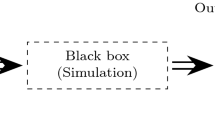Abstract
Black-box optimization problems when the input space is a high-dimensional space or a function space appear in more and more applications. In this context, the methods available for finite-dimensional data do not apply. The aim is then to propose a general method for optimization involving dimension reduction techniques. Different dimension reduction basis are considered (including data-driven basis). The methodology is illustrated on simulated functional data. The choice of the different parameters, in particular the dimension of the approximation space, is discussed. The method is finally applied to a problem of nuclear safety.












Source: CEA



Similar content being viewed by others
Notes
French Alternative Energies and Atomic Energy Commission (Commissariat à l’énergie atomique et aux énergies alternatives), government-funded technological research organisation. http://www.cea.fr/.
References
Box GEP, Hunter JS (1957) Multi-factor experimental designs for exploring response surfaces. Ann Math Stat 28(1):195–241
Brunel É, Mas A, Roche A (2016) Non-asymptotic adaptive prediction in functional linear models. J Multivariate Anal 143:208–232
Cardot H, Ferraty F, Sarda P (1999) Functional linear model. Stat Probab Lett 45(1):11–22
Cardot H, Sarda P (2010) Functional linear regression. In: Ferraty F, Romain Y (eds) Handbook of functional data analysis. Oxford University Press, pp 21–46
Delaigle A, Hall P (2012) Methodology and theory for partial least squares applied to functional data. Ann Stat 40(1):322–352
Draper NR, Guttman I (1988) An index of rotatability. Technometrics 30(1):105–111
Draper NR, Lin DKJ (1990) Small response-surface designs. Technometrics 32(2):187–194
Draper NR, Pukelsheim F (1990) Another look at rotatability. Technometrics 32(2):195–202
Durantin C, Marzat J, Balesdent M (2016) Analysis of multi-objective Kriging-based methods for constrained global optimization. Comput Optim Appl 63(3):903–926
Engl HW, Hanke M, Neubauer A (1996) Regularization of inverse problems, mathematics and its applications, vol 375. Kluwer Academic Publishers Group, Dordrecht
Georgiou SD, Stylianou S, Aggarwal M (2014) A class of composite designs for response surface methodology. Comput Stat Data Anal 71:1124–1133
Gunst RF, Mason RL (2009) Fractional factorial design. WIREs Comput Stat 1(2):234–244
Hall P (2011) Principal component analysis for functional data: methodology, theory, and discussion. In: The Oxford handbook of functional data analysis, pp 210–234. Oxford University Press, Oxford
Khuri AI (1988) A measure of rotatability for response-surface designs. Technometrics 30(1):95–104
Khuri AI (2001) An overview of the use of generalized linear models in response surface methodology. In: Proceedings of the third world congress of nonlinear analysts, Part 3 (Catania, 2000), vol 47, pp 2023–2034 . No. 3
Khuri AI, Mukhopadhyay S (2010) Response surface methodology. Wiley Interdiscip Rev Comput Stat 2(2):128–149
Lee SY, Zhang W, Song XY (2002) Estimating the covariance function with functional data. Br J Math Stat Psychol 55(2):247–261
Lenth RV (2009) Response-surface methods in R, using RSM. J Stat Softw 32(7):1–17
Liu H, Xu S, Ma Y, Wang X (2015a) Global optimization of expensive black box functions using potential Lipschitz constants and response surfaces. J Glob Optim 63(2):229–251
Liu Z, Li W, Yang M (2015b) Two general extension algorithms of latin hypercube sampling. Math Probl Eng pp Art. ID 450,492,9
Morris MD (2000) A class of three-level experimental designs for response surface modeling. Technometrics 42(2):111–121
Müller HG, Stadtmüller U (2005) Generalized functional linear models. Ann Stat 33(2):774–805
Myers RH, Montgomery DC, Anderson-Cook CM (2009) Response surface methodology. Process and product optimization using designed experiments, 3rd edn. Wiley series in probability and statistics. Wiley, Hoboken
Park SH, Lim JH, Baba Y (1993) A measure of rotatability for second order response surface designs. Ann Inst Stat Math 45(4):655–664
Pázman A (1986) Foundations of optimum experimental design, mathematics and its applications (East European Series), vol 14. D. Reidel Publishing Co., Dordrecht (Translated from the Czech)
Preda C, Saporta G (2005) PLS regression on a stochastic process. Comput Stat Data Anal 48(1):149–158
Qi X, Luo R (2015) Sparse principal component analysis in Hilbert space. Scand J Stat 42(1):270–289
Queipo N, Haftka RT, Shyy W, Goel T, Vaidyanathan R, Tucker P (2005) Surrogate-based analysis and optimization. Prog Aerosp Sci 41(1):1–28
Ramsay J, Silverman B (2005) Functional data analysis, 2nd edn. Springer, New York
Ramsay JO, Dalzell CJ (1991) Some tools for functional data analysis. J R Stat Soc B Methods 53(3):539–572
Rice JA, Silverman BW (1991) Estimating the mean and covariance structure nonparametrically when the data are curves. J R Stat Soc Ser B 53(1):233–243
Simpson T, Poplinski J, Koch P, Allen J (2001) Metamodels for computer-based engineering design: survey and recommendations. Eng Comput 17(2):129–150
Tang Y, Chen J, Wei J (2013) A surrogate-based particle swarm optimization algorithm for solving optimization problems with expensive black box functions. Eng Optim 45(5):557–576
Wold H (1975) Soft modelling by latent variables: the non-linear iterative partial least squares (NIPALS) approach. In: Perspectives in probability and statistics (papers in honour of M. S. Bartlett on the occasion of his 65th birthday), pp 117–142. Applied Probability Trust, University of Sheffield, Sheffield
Zou H, Hastie T, Tibshirani R (2006) Sparse principal component analysis. J Comput Graph Stat 15(2):265–286
Author information
Authors and Affiliations
Corresponding author
Rights and permissions
About this article
Cite this article
Roche, A. Local optimization of black-box functions with high or infinite-dimensional inputs: application to nuclear safety. Comput Stat 33, 467–485 (2018). https://doi.org/10.1007/s00180-017-0751-1
Received:
Accepted:
Published:
Issue Date:
DOI: https://doi.org/10.1007/s00180-017-0751-1




